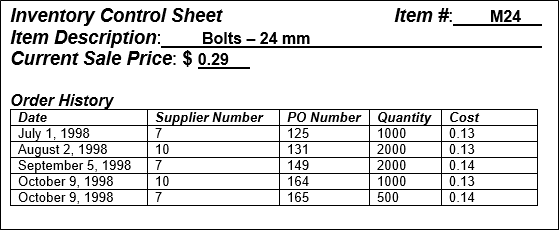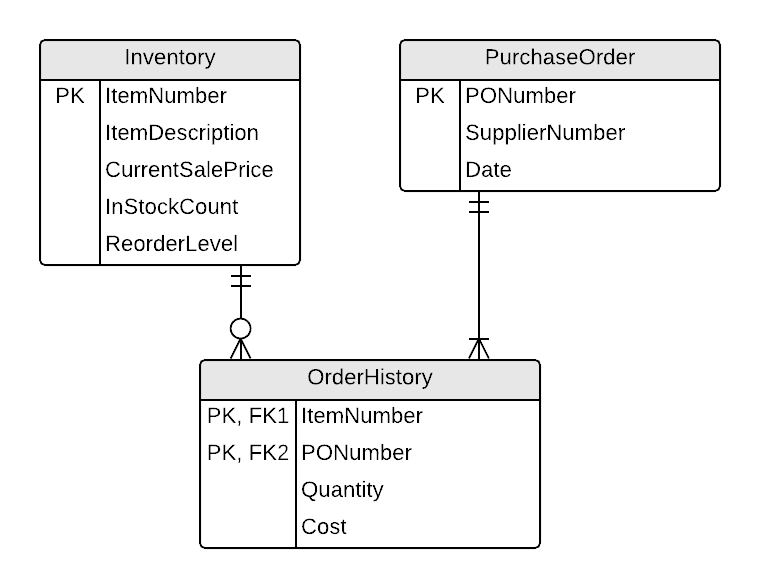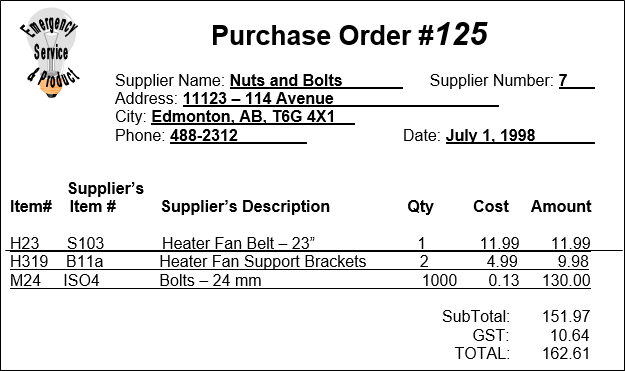ESP Document 3
The third specifications document for Emergency Service & Product (ESP) presented two additional paper-based forms: Inventory Control Sheet and Purchase Orders. This portion of the sample lab solution details how this form was analyzed and integrated into the database design from the previous documents. The styling conforms to the associated [Legend.md](normalization legend).
The markdown for this file can be found in the source repository.
Inventory Control Sheet
The Inventory Control Sheet and its resulting tables are based on the following form (taken from the original documentation).

This form was analyzed according to the rules of 0NF (Zero-Normal Form), 1NF (First-Normal Form), 2NF (Second-Normal Form), and 3NF (Third-Normal Form).
0NF
After performing Zero-Normal Form, a single table was generated: Inventory.
Inventory (ItemNumber, ItemDescription, CurrentSalePrice, Date, SupplierNumber, PONumber, Quantity, Cost, InStockCount, ReorderValue)
1NF
After performing First-Normal Form, a single table was generated: OrderHistory.
Inventory (ItemNumber, ItemDescription, CurrentSalePrice, InStockCount, ReorderValue)
OrderHistory (ItemNumber, PONumber, SupplierNumber, Date, Quantity, Cost)
2NF
After performing First-Normal Form, a single table was generated: PurchaseOrder.
Q) Why did I leave the
QuantityandCostin the OrderHistory entity while moving theSupplierNumberandDateto the PurchaseOrder?A) 2NF is about Partial Dependencies, and I am looking to see if any of the attributes from OrderHistory were tightly related to only the
PONumberattribute. It turns out that theSupplierNumberidentifies the supplier for the Purchase Order and theDateidentifies when the Purchase Order was placed. But, theQuantitydescribes the number of Inventory Items (ItemNumber) that were purchased (PONumber) and theCostdescribes how much I paid for the item on that particular purchase order.
OrderHistory (ItemNumber, PONumber, Quantity, Cost)
PurchaseOrder (PONumber, SupplierNumber, Date)
3NF
When performing Third-Normal Form, no transitive dependencies were identified, and the tables have not changed.
Final Set of Entities and ERD
The final set of entities after completing Third-Normal-Form are as follows:
Inventory (ItemNumber, ItemDescription, CurrentSalePrice, InStockCount, ReorderValue)
OrderHistory (ItemNumber, PONumber, Quantity, Cost)
PurchaseOrder (PONumber, SupplierNumber, Date)
The ERD for this view is as follows:

Expressed in English, the relationships between the entities would read as follows.
Each Inventory item must be purchased as one or more OrderHistories. Each OrderHistory must be describing the purchase of one and only one Inventory item. Each OrderHistory must be a detail in one and only one PurchaseOrder. Each PurchaseOrder must be comprised of one or more OrderHistories.
Note
Note that the name choices for your entities may make it difficult when translating the ERD to English.
Purchase Orders
The Purchase Order and its resulting tables are based on the following form (taken from the original documentation).

This form was analyzed according to the rules of 0NF (Zero-Normal Form), 1NF (First-Normal Form), 2NF (Second-Normal Form), and 3NF (Third-Normal Form).
0NF
After performing Zero-Normal Form, a single table was generated: PurchaseOrder.
PurchaseOrder (PurchaseOrderNumber, SupplierName, SupplierNumber, Address, City, Province, PostalCode, Phone, Date, ItemNumber, SupplierItemNumber, SupplierDescription, Quantity, Cost, Amount, SubTotal, GST, Total)
1NF
After performing First-Normal Form, a single table was generated: PurchaseOrderItem.
PurchaseOrder (PurchaseOrderNumber, SupplierName, SupplierNumber, Address, City, Province, PostalCode, Phone, Date, SubTotal, GST, Total)
PurchaseOrderItem (PurchaseOrderNumber, ItemNumber, SupplierItemNumber, SupplierDescription, Quantity, Cost, Amount)
2NF
After performing Second-Normal Form, no clear partial dependencies were identified; therefore, the tables have not changed.
At first glance, it might appear that SupplierItemNumber and SupplierDescription are partial dependencies on ItemNumber (perhaps along with the Cost). However, further reflection reveals that this tracking of what name and price the supplier uses for the item is far too difficult to maintain; we should only be concerned with tracking the items belonging to ESP. Tracking supplier inventory names, numbers & costs is a "rabbit trail" of volatile data that we can't (and don't want to) pursue.
3NF
After performing Third-Normal Form, a new table was generated: Supplier.
PurchaseOrder (PurchaseOrderNumber, SupplierNumber, Date, SubTotal, GST, Total)
Supplier (SupplierNumber, SupplierName, Address, City, Province, PostalCode, Phone)
PurchaseOrderItem(PurchaseOrderNumber, ItemNumber, SupplierItemNumber, SupplierDescription, Quantity, Cost, Amount)
ERD
